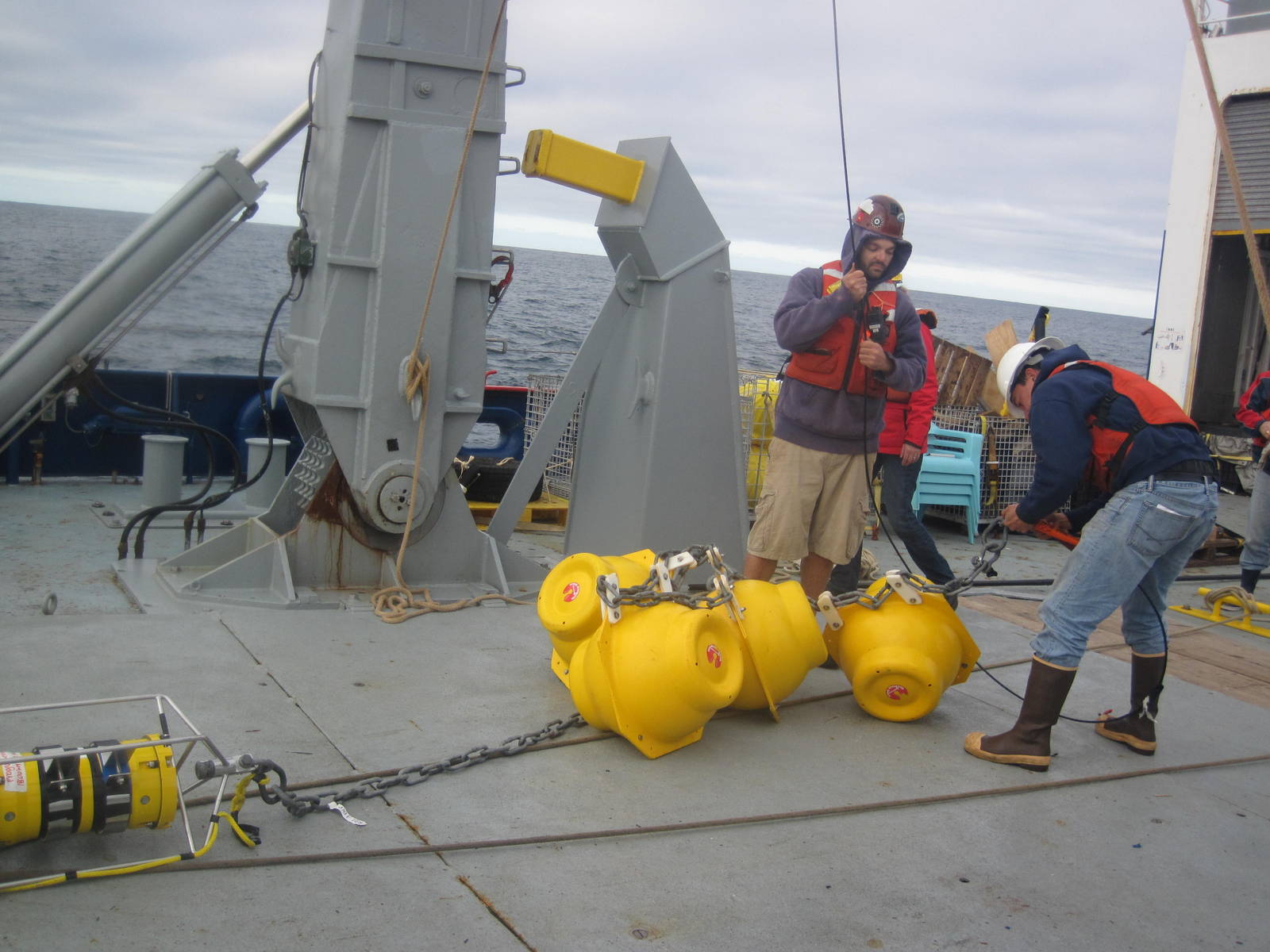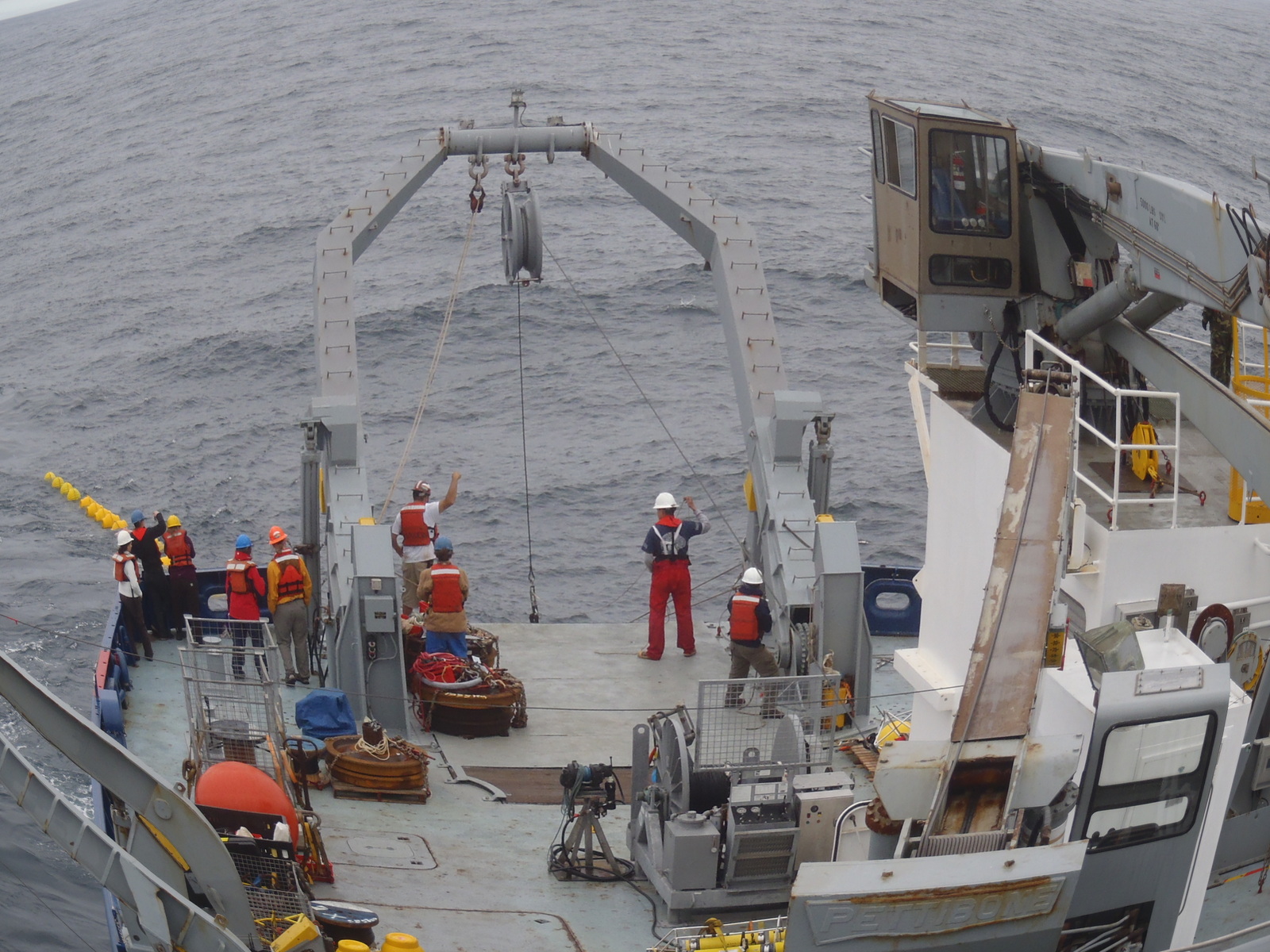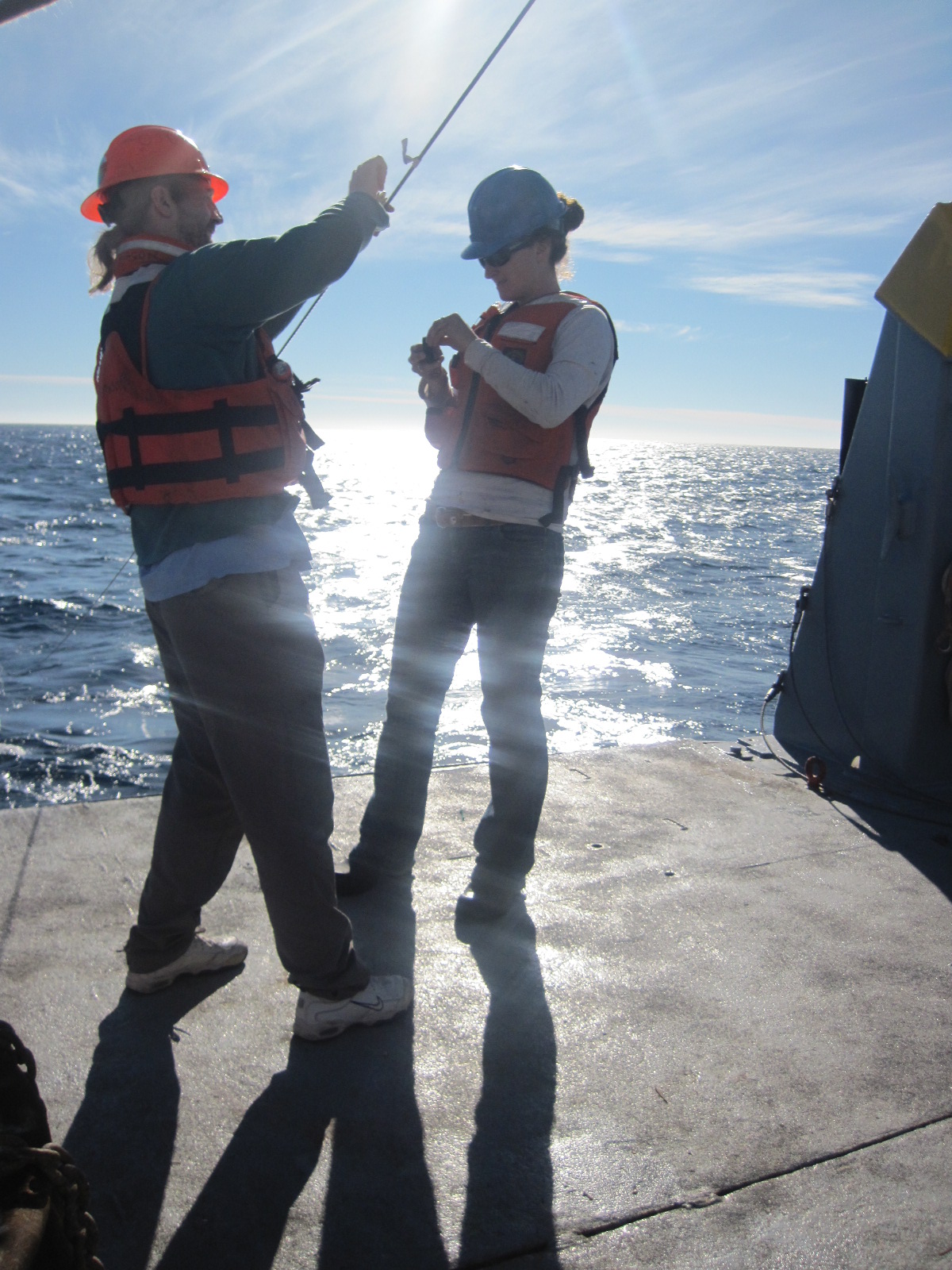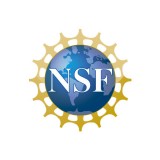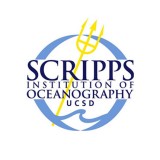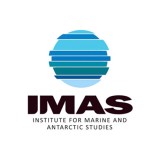Every day, the ocean’s tides create massive underwater waves known as internal tides that radiate around the globe with major impacts on the ocean’s heat budget and climate.
Little is known about how these subsurface water movements propagate and dissipate in the open ocean, but that’s set to change during Falkor’s first expedition of 2015. Collaborators from U.S. and Australian institutions will run the first comprehensive study of the largest, most focused internal tide on the planet, which moves across the Tasman Sea each day. In the process they will amass data that will improve general understanding of the phenomenon, as well as researchers’ ability to incorporate internal tide effects accurately in climate models.
Amy Waterhouse, at the Scripps Institution of Oceanography, and Samuel Kelly, from the University of Minnesota, Duluth, will co-lead the January 17th to February 13th expedition, called T-Beam. Other team members will come from the University of Washington’s Applied Physics Lab, the University of Alaska Fairbanks, theUniversity of Tasmania, the Commonwealth Scientific and Industrial Research Organisation (CSIRO), and the Environmental Protection Agency of Victoria.
What’s an Internal Tide?
Internal tides form when regular tides that we are more familiar with push water up and over seafloor features such as seamounts or ridges. The turbulence created by that movement spawns underwater waves that can move out in multiple horizontal directions. These waves also reflect off the sea surface and the seafloor, so they can be found at any depth.
If you watched an internal tide’s wave passing from the surface, it would be barely noticeable. But, lower down, the wave can be up to hundreds of meters high. That is larger than any surface wave and more than powerful enough to push a human up and down—or even a whale or a submarine. As these waves move, they push layers of ocean water of varying temperatures up and down, and their friction and turbulence dissipate energy. Both effects are important, because they partially determine how much heat from the atmosphere the ocean can absorb. This can lead to major effects on the atmosphere and climate we enjoy above the sea surface.
A Subsea Wave Lab
The T-Beam team will be studying the Tasman internal tide because it is uniquely pronounced and organized. Internal tides normally move in multiple horizontal directions, making them hard to track and study. The Tasman internal tide is the only one known in the world that moves almost completely in one direction. It forms at a ridge south of New Zealand then pushes west toward Tasmania, where it breaks on the continental shelf (see map), unseen from above.
That focus comes about because the ridge where it forms is steep, funneling almost all the tidal energy toward Tasmania, and the seafloor is relatively free of direction-diverting structures all the way across. Collectively, these conditions make the Tasman Sea a natural laboratory for an internal tide study.
Researchers have little data on the Tasman internal tide because the area is remote, and ocean conditions there can be treacherous. This expedition is scheduled for the austral summer, when conditions are typically calmest.
Tracking the Flow
The team will focus most of their work on eleven stations in the middle of the wave’s path. As data come in, researchers will be able to optimize their plan for sampling sites on the fly. That is thanks to the recent installation of the world’s first ship based supercomputer on Falkor. This cloud-based, high performance computing system from Nebula will offer processing power at a level researchers would normally only have access to on land.
At each site they will lower sensors on Falkor’s CTD rosette to gather data all the way to the bottom in depths up to 4,500 meters. This will include current sensors called acoustic Doppler current profilers (ADCPs), as well as chi-pods, which are devices developed at Oregon State University that measure minute temperature variations as indicators of turbulence. The team will also regularly collect water samples with the CTD rosette to measure nutrient concentrations, which can be significantly affected by an internal tide, particularly when it brings deeper, more nutrient rich waters up toward the surface.
The overall goal will be to quantify the velocity of water movement at all depths to discern the movement and speed of the internal tide as it passes twice during a 30-hour span at each site. The effects of the tide will be indicated not only by water turbulence but changes in temperatures as the wave moves water layers up and down. The team will also be comparing their data against that from satellites that can provide some information on current movements.
One challenge will be to carefully tease out the effects of the internal tide wave from the region’s eddy currents. Eddies are circular currents that spin off of larger currents and can reduce the width of the tide wave, or change its path. So, better understanding them is key to fully understanding the internal tide.
The team will be coordinating all of this work with a concurrent expedition by a separate group aboard the Scripps ship R/V Roger Revelle that is part of a National Science Foundation-funded experiment dubbed T-TIDE. This group will mainly be studying the internal tide’s movements and effects after it actually breaks in shallower water on the Tasmanian shelf. But the Revelle group will also be deploying two moorings for the Falkor team on the continental shelf and offshore in the T-Beam study area.
The moorings are anchored cables equipped with dozens of temperature sensors and multiple current and CTD profilers that will provide vital, longer-term data on the internal tides. Additional collaborations will include the Falkor team coming in to the shelf for several days of coordinated research with the Revelle collecting supplementary data to ensure the highest resolution maps of the wave’s dissipation there.
Putting the Data to Use
Ultimately, both teams will combine their datasets to build a computer model of the Tasman internal tide that may become the most accurate model ever created for any internal tide. This model will help researchers better understand the Tasman region and may also aid in improving future management. For instance, knowing where the internal tide concentrates nutrients either by bringing nutrient-rich deeper water toward the surface or by kicking up nutrients in sediments on the shelf could help identify areas key to certain fisheries and potentially in need of increased attention or protection.
This work has global application because of that unique ‘natural laboratory’ side of the Tasman Sea. Scientists and managers will be able to use the Tasman model to dramatically improve modeling of the more complicated internal tides around the globe. This will hopefully lead to major improvements in global climate models, and better understanding of the ocean’s importance in governing climate processes.
by Mark Schrope
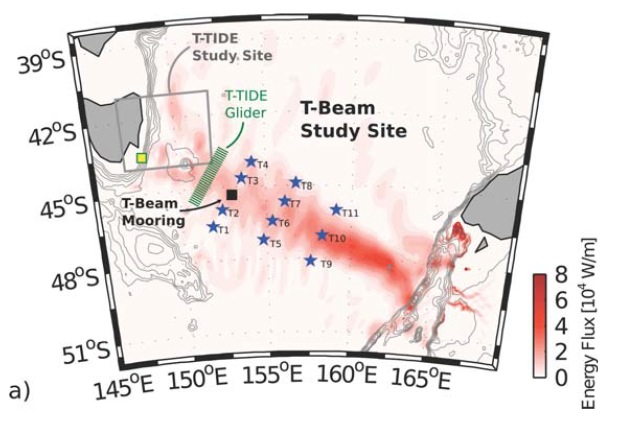
Data & Publications
The resulting shipboard dataset is being stored at the Rolling Deck to Repository and is now available.
Preliminary Visualizations of the data are now available:
Metadata for Preliminary Visualizations
Mode-1 generation & energy flux
Navigation, Swath Bathymetry and LADCP (velocity, temperature, salinity) data are available through the Marine Geoscience Data System.
ADCP data is curated and archived by University of Hawaii.
Modeling Results from this cruise were contributed to the following publications:
Johnston, T.M.S., Rudnick, D., and Kelly, S. (2015). Standing Internal Tides in the Tasman Sea Observed by Gliders, J. Phys. Oceanography, 45, 2715-2737, doi: 10.1175/JPO-D-15-0038.1.
Klymak, J., et. al. (2015). Reflection of Linear Internal Tides from Realistic Topography: The Tasman Continental Slope, J. Phys. Oceanography, 46, 3321-3337, doi: 10.1175/JPO-D-16-0061.1.
- Pinkel, R., et. al. (2015). Breaking Internal Tides Keep the Ocean in Balance. EOS, 96, doi:10.1029/201EO039555.
- Kelly, S., et. al. (2016). Uncertainties of Internal Tide Generation and Energy Flux in the Tasman Sea, Poster Presentation at Ocean Sciences Meeting 2016, New Orleans, LA, USA.
- Pinkel, R., et. al. (2016). The Tasman Tidal Dissipation Experiment: Tidal Mixing, Scattering, and Reflection on the East Tasman Slope, Oral Presentation, Ocean Sciences Meeting 2016, New Orleans, LA, USA.
- Simmons, H., et. al. (2016). The Internal Tide of the Tasman Sea, Poster Presentation at Ocean Sciences Meeting 2016, New Orleans, LA, USA.
- Waterhouse, A., et. al. (2016). Observations of an Internal Tide Beam in the Tasman Sea, Oral Presentation at Ocean Sciences Meeting 2016, New Orleans, LA, USA.
- Kelly, S. (2016). The Moon, Climate, and Ocean Turbulence, Guest Lecturer, Concordia College, Moorhead, MN, USA.
- Kelly, S. (2016). The Moon, Climate, and Ocean Turbulence, Guest Lecturer, Gustavus Adolphus College, St. Peter, MN, USA.
- Kelly, S. (2016). The Moon, Climate, and Ocean Turbulence, Guest Lecturer, St. Olaf College, Northfield, MN, USA.
- Kelly, S. (2016). The Moon, Climate, and Ocean Turbulence, Guest Lecturer, University of Minnesota Duluth, Duluth, MN, USA.
- Kelly, S. (2016). The Moon, Climate, and Ocean Turbulence, Guest Lecturer, University of Wisconsin La Crosse, La Crosse, WI, USA.
- Klymak, J., Simmons, H., Braznikov, D., Kelly, S., MacKinnon, J., Alford, M., et. al. (2016). Reflection of Linear Internal Tides from Realistic Topography: The Tasman Continental Slope. Journal of Physical Oceanography, 46(11), 3321-3337, doi: 10.1175/JPO-D-16-0061.1.
- Waterhouse, A., (2016). Associate for Women in Science San Diego Chapter Science, Technology, Engineering, and Math Panel, Panelist, San Diego, CA, USA.
- Waterhouse, A., Kelly, S., Zhao, Z., MacKinnon, J., Nash, J., Simmons, H., Brahznikov, D., Rainville, L, Alford, M., and Pinkel, R. (2018). Observations of the Tasman Sea Internal Tide Beam. J. Phys. Oceanogr., 48, 1283-1297, doi: 10.1175/JPA-D-17-0116.1.
- Savage, A., Waterhouse, A., Kelly, S., and J. MacKinnon. (2018). Noncoherence of low mode internal tides in the Tasman Sea, Oral Presentation, Ocean Sciences Meeting, Portland, OR, USA.
- Marques, O., Alford, M., Pinkel, R., Mackinnon, J., Nash, J., Simmons, H., Brazhnikov, D., Klymak, J., Waterhouse, A., and S. Kelly. (2018). Internal Tide Structure and Variability on the Tasman Slope, Oral Presentation, Ocean Sciences Meeting, Portland, OR, USA.
- Su, J. (2018). An evaluation of vertical nitrate fluxes and biological demand in the tropical Pacific and Tasman Sea. BSc. Hons. Thesis, University of Tasmania.
- Su, J. (2018). An evaluation of vertical nitrate fluxes and biological demand in the tropical Pacific and Tasman Sea. Poster presentation, Australian Meteorological and Oceanographic Society Annual Conference, New South Wales, AUS.
- Kelly, S. (2019). Dynamical Separation of Stationary and Non-stationary internal tides. Oral presentation at NASA Surface Water and Ocean Topography Meeting, Bordeaux, France.
- Savage, A., Waterhouse, A., and Kelly, S. (2020). Internal Tide nonstationarity and Wave-mesoscale Interactions in the Tasman Sea. Journal of Physical Oceanography, 50(10), doi: 10.1175/JPO-D-19-0283.1.
- Marques, O., Alford, M., Pinkel, R., MacKinnon, J., Klymak, J., Nash. J., et. al. (2020). Internal Tide Structure and Temporal Variability on the Reflective Continental Slope of Southeastern Tasmania. Journal of Physical Oceanography, doi: 10.1175/JPO-D-20-0044.1.
- Kelly, S., Waterhouse, A., and Savage, A. (2021). Global Dynamics of the Stationary M2 Mode-1 Internal Tide, Geophys. Res. Lett., 48, doi: 10.1029/2020GL091692. [This article has been published as OPEN ACCESS].
In the News
Chasing Giant Tides in Australia
All Things Marine Radio Show • February 17th, 2015
Mystery of the Underwater Waves as tall as Skyscrapers
Daily Mail • January 28th, 2015
Watch a 1000 Foot-High-Wave Move Across The Ocean
Yahoo News • January 27th, 2015
Giant underwater wave mystery
Radio New Zealand News • January 15th, 2015
Scientists study Tasman Sea’s hidden monster waves
The New Zealand Herald • January 9th, 2015
Oceanographers study power of underwater waves off Tasmania’s east coast
The Mercury • January 8th, 2015
International Team will Scrutinize the Ocean’s Skyscraper-High Internal Waves off Australia
Scripps Institution of Oceanography • January 8th, 2015
Giant Underwater Waves Could Hold Secrets of Climate Forecasting and Improved Fisheries
Australian Broadcasting Corporation (ABC) News • January 7th, 2015
Huge Slow Moving Internal Waves Wreak Havoc
Discovery News • January 6th, 2015
